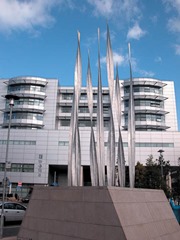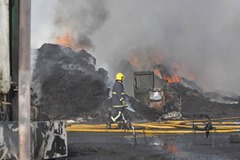What is a major incident?
 The major incident process was used at Belfast’s Royal Victoria Hospital in January, to bring in extra A&E staff. agendaNi looks at what would happen in any major incident and the Executive’s plans for responding.
The major incident process was used at Belfast’s Royal Victoria Hospital in January, to bring in extra A&E staff. agendaNi looks at what would happen in any major incident and the Executive’s plans for responding.
The decision to declare a major incident at the Royal Victoria Hospital on 8 January has focused attention on how the authorities respond to emergencies. In this case, the Belfast Health and Social Care Trust has acknowledged that a major incident did not actually take place but instead it was using the procedure to bring in more staff.
A trust spokeswoman told agendaNi that the A&E department had “experienced extreme pressures … and as a result, a decision was made to utilise the major incident paging system to call in additional staff at short notice”. She added: “Our staff dealt professionally and quickly with the situation and within a few hours it was rectified.”
This process is designed to be used in the event of a more serious emergency. The official definition of a major incident is “an event or situation which threatens serious damage to human welfare, the environment or the security of Northern Ireland or the UK as a whole.”
Such incidents in recent years have included the Fermanagh floods in 2009, the severe freeze in 2010, the heavy snowfall last spring, and the storm surge in early January of this year.
Emergency planning is co-ordinated by the Civil Contingencies Policy Branch in OFMDFM. Central government has three main tasks in an emergency:
1. protect human life and, as far as possible, property and alleviate suffering;
2. support the continuity of everyday activity and the restoration of disrupted services; and
3. uphold the rule of law and the democratic process.
The branch’s framework for emergencies is not a strict guide to every situation. Indeed, it emphasises flexibility and innovation: “Exercises, near misses and actual incidents can illustrate where arrangements are deficient and suggest new, more effective ways of doing things.”
Essential public safety information needs to be disseminated quickly so that people can take the right action. The Executive Information Service can require the BBC to interrupt programmes if this is necessary.
Other information may need to be carefully managed e.g. names of fatalities should not be released until those involved have been formally identified and their relatives have been informed.
 The main agencies involved in emergency planning regularly meet through the Civil Contingencies Group, which can turn itself into a temporary central operations room. The response to a specific emergency is led by a ‘crisis management group’ headed up by a Minister. The group reports back to the Executive and can call on any part of the Civil Service for assistance through the Head of the Civil Service, Malcolm McKibbin.
The main agencies involved in emergency planning regularly meet through the Civil Contingencies Group, which can turn itself into a temporary central operations room. The response to a specific emergency is led by a ‘crisis management group’ headed up by a Minister. The group reports back to the Executive and can call on any part of the Civil Service for assistance through the Head of the Civil Service, Malcolm McKibbin.
A ‘strategic lead organisation’ is assigned to each type of major incident (see table). If an evacuation is needed, the PSNI will take the lead and contact residents. Health trusts are responsible for organising ‘rest centres’ for evacuees. Afterwards, the Chief Executive of the local council then takes the lead on the resettlement of residents and the reconstruction of property.
Another OFMDFM paper – ‘Northern Ireland Standards in Civil Protection’ – comments that the media “can be a useful ally or a dangerous foe” in emergencies.
It continues: “Most media representatives are committed to providing a balanced, truthful report on events, but they are under pressure from their employers to provide material, often at short notice and preferably exclusive. It is very important that organisations can meet reasonable media demands and manage the less disciplined media elements.”
The Northern Ireland Office and the Irish Department of Foreign Affairs can be contacted for extra assistance. For example, Irish Air Corps and RAF helicopters lifted feed to farms that were cut off by snow in the Antrim Hills last year.
If a particular security threat is identified, the information will be sent directly from the PSNI to the NIO, where the Minister of State (Andrew Robathan) will take the lead.
Anyone who is declaring a major incident has to consider its wider impact. Sending all ambulances and fire engines to one location leaves the rest of a district without cover, making another emergency more likely.
Governments also need to plan for the most serious emergencies. The UK Government’s Cold War plans envisaged that Stormont would be abandoned if war broke out with the Soviet Union. Ministers and up to 230 senior officials would have been moved to a bunker. The first was built at Mount Eden Park in South Belfast and a second, newer bunker was completed at the Woodside Industrial Estate, Ballymena, during the late 1980s.
General emergency advice to the public is published at www.nidirect.gov.uk
Strategic leads
| Type | Lead |
| Bio-security | DARD |
| Coastal pollution | Environment Agency |
| Electronic attack | DFP |
| Flooding | Rivers Agency |
| Food contamination | Food Standards Agency |
| Infectious disease | DHSSPS |
| Offshore | Coastguard |
| Power failure | DETI |
| Radiation | Environment Agency |
| Terrorism | NIO |
| Transport-related | DRD |
| Water contamination | NI Water |





